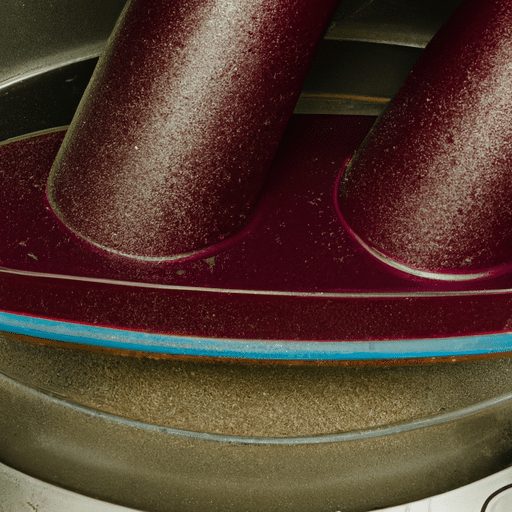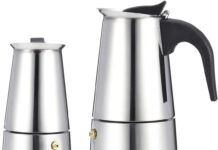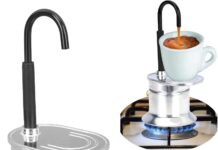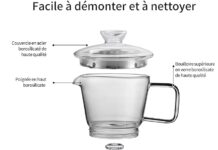Maintaining a clean coffee maker is essential for both the taste and longevity of your beloved caffeinated essential. In this article, we will explore the importance of regular cleaning, discuss potential issues that arise from neglecting this task, and provide useful tips on how often you should clean your trustworthy coffee maker. So grab your favorite mug, and let’s ensure your mornings always kick off with a perfect cup of coffee!
Importance of Cleaning a Coffee Maker
A clean coffee maker is essential for not only ensuring a great tasting cup of coffee but also for maintaining the overall health and longevity of the machine. Over time, coffee makers can accumulate coffee residue, mineral deposits, and bacteria, which can negatively impact the flavor of your coffee and even lead to the growth of mold and other harmful substances. By regularly cleaning your coffee maker, you can not only enjoy a better tasting cup of coffee but also extend the lifespan of your machine.
Factors Affecting Cleaning Frequency
Type of Coffee Maker
The type of coffee maker you have plays a significant role in determining how frequently it needs to be cleaned. Different coffee makers have different designs and mechanisms that can vary in their susceptibility to buildup and residue. For example, drip coffee makers, single-serve coffee makers, French presses, and espresso machines each require different cleaning methods and schedules. It is important to consider the specific recommendations provided by the manufacturer for your particular type of coffee maker.
Frequency of Use
The frequency at which you use your coffee maker also impacts the cleaning schedule. If you use your coffee maker every day, it is recommended to clean it more frequently compared to occasional or infrequent users. Regular use can lead to a quicker accumulation of coffee grounds, mineral deposits, and other contaminants, making more frequent cleaning necessary.
Type of Water Used
The type of water you use in your coffee maker can affect the buildup of minerals and residue. Hard water, which contains a high concentration of minerals like calcium and magnesium, can lead to mineral deposits in the coffee maker. These deposits not only affect the flavor of the coffee but can also clog the machine and decrease its efficiency. Using filtered or distilled water can help reduce mineral buildup and prolong the intervals between cleanings.
Coffee Residue Buildup
Over time, coffee residue can accumulate inside the coffee maker and affect the taste of your brew. Oils from the coffee can turn rancid and become a breeding ground for bacteria. As a general rule of thumb, if you notice a significant amount of residue or a stale taste in your coffee, it’s time to clean your coffee maker.
Signs that Your Coffee Maker Needs Cleaning
Off-Taste in Coffee
One of the most noticeable signs that your coffee maker needs cleaning is when your coffee starts to taste off or stale. This off-taste is often a result of coffee residue buildup or mineral deposits that haven’t been properly cleaned. Regular cleaning can help ensure that your coffee tastes fresh and delicious every time.
Slow Brewing Process
If your coffee is taking longer than usual to brew, it could be an indication that your coffee maker needs cleaning. Mineral deposits and residue can clog the internal components of the machine, causing it to work less efficiently. By cleaning your coffee maker regularly, you can ensure a faster and more consistent brewing process.
Coffee Grounds in Brewed Coffee
Another sign that your coffee maker is in need of cleaning is the presence of coffee grounds in your brewed coffee. This can occur when the filter basket or other components are not properly cleaned or maintained. Cleaning these parts regularly will help prevent the grounds from finding their way into your cup of joe.
Daily Maintenance Tips
Emptying and Rinsing the Pot
After each use, it is important to empty the pot and give it a thorough rinse. Coffee residue can accumulate in the pot and, if left uncleaned, can affect the taste of future brews. Rinse the pot with warm water and mild dish soap to remove any residue and ensure a fresh start for your next pot of coffee.
Cleaning the Exterior
Although the internal components of the coffee maker are crucial for its performance, it’s also important to clean the exterior regularly. Wipe down the exterior with a damp cloth to remove any dust, spills, or stains. This will not only keep your coffee maker looking clean and presentable but also prevent any external dirt from finding its way into the machine’s internal parts.
Wiping the Warming Plate
If your coffee maker has a warming plate, make sure to wipe it regularly. Coffee spills and residue can accumulate on the warming plate, which can affect the taste of subsequent cups of coffee. Use a damp cloth to clean the warming plate and prevent any burnt coffee remnants from impacting the flavor of your brew.
Regular Cleaning Schedule
Weekly Cleaning
In addition to daily maintenance, a weekly deep cleaning is recommended to keep your coffee maker in optimal condition. This involves a more thorough cleaning of the internal components to remove any accumulated residue or mineral deposits that might affect the flavor and performance of your coffee maker. Refer to the cleaning instructions provided by the manufacturer for your specific coffee maker model.
Monthly Cleaning
In addition to weekly cleaning, a monthly deep cleaning is essential for maintaining the long-term performance of your coffee maker. This thorough cleaning should include descaling the machine to remove any mineral deposits, cleaning the water reservoir, filter basket, and other removable components, and ensuring that the entire machine is free from any residue or build-up. This monthly cleaning routine will help prolong the lifespan of your coffee maker and optimize the flavor of your coffee.
Deep Cleaning Methods
Vinegar Cleaning
Vinegar is a natural and effective cleaning agent that can be used to clean your coffee maker. To perform a vinegar cleaning, mix equal parts white vinegar and water and pour the solution into the water reservoir. Run a brew cycle without any coffee grounds and then repeat the process with plain water to rinse out any residual vinegar. This method helps to remove mineral deposits and coffee residue, leaving your coffee maker clean and odor-free.
Baking Soda Cleaning
Baking soda is another versatile household ingredient that can be used to clean your coffee maker. Create a paste by mixing baking soda with water and apply it to the internal components of the machine. Scrub gently with a sponge or brush to remove any stubborn stains or residue. Rinse thoroughly with water to ensure all traces of the baking soda are removed. Baking soda not only cleans effectively but also helps to eliminate any lingering odors in the coffee maker.
Citric Acid Cleaning
Citric acid is a natural and powerful cleaner that can be used to descale your coffee maker. Dissolve citric acid powder in water according to the manufacturer’s instructions and pour the solution into the water reservoir. Run a brew cycle without coffee grounds and repeat the process with plain water to rinse. Citric acid effectively removes mineral deposits, leaving your coffee maker clean and free from any impurities.
Cleaning Different Types of Coffee Makers
Drip Coffee Maker
To clean a drip coffee maker, start by emptying and rinsing the pot and removing any remaining coffee grounds. Follow the manufacturer’s instructions for removing and cleaning the filter basket and other removable parts. Depending on your coffee maker’s specific instructions, you can use vinegar, baking soda, or citric acid cleaning methods to deep clean the machine. Run one or two brew cycles with plain water to ensure any cleaning solution or residue is thoroughly rinsed out.
Single-Serve Coffee Maker
Cleaning a single-serve coffee maker involves a similar process to a drip coffee maker. Start by emptying and rinsing the water reservoir and removing any used coffee pods or capsules. Follow the manufacturer’s instructions for cleaning the removable parts, such as the pod holder or drip tray. You can use the same cleaning methods, such as vinegar or baking soda, to clean the internal components. Finish by running one or two brew cycles with plain water to remove any cleaning solution or residue.
French Press
Cleaning a French press is relatively straightforward. Start by separating the plunger assembly from the glass carafe. Dispose of the used coffee grounds and rinse the carafe and plunger assembly with warm water. For a deeper clean, use a gentle dish soap and scrub gently with a sponge or brush. Rinse thoroughly to remove any soap residue before reassembling the French press.
Espresso Machine
Cleaning an espresso machine requires a more thorough approach due to the complexity of the machine. Follow the manufacturer’s instructions for the specific cleaning procedures and products recommended for your espresso machine. This may include descaling the machine, cleaning the group head, steam wand, and portafilter. Regular cleaning and maintenance of an espresso machine are crucial for the machine’s performance and the quality of the espresso it produces.
Cleaning Additional Coffee Maker Components
Water Reservoir
The water reservoir of your coffee maker should be regularly cleaned to avoid any build-up of mineral deposits or bacteria. Refer to the manufacturer’s instructions for your specific coffee maker to determine the best cleaning method. Depending on the manufacturer’s recommendations, you may be able to clean the water reservoir by hand, in the dishwasher, or with a cleaning solution specifically designed for coffee makers.
Filter Basket
The filter basket of a coffee maker is another component that requires regular cleaning. Remove the filter basket from the machine and discard the used coffee grounds. Rinse the filter basket with warm water to remove any residue. Depending on your specific coffee maker, the filter basket may be dishwasher safe, in which case you can clean it in the dishwasher for a thorough clean.
Drip Tray
The drip tray collects any excess water or spilled coffee during the brewing process. Regularly empty and rinse the drip tray to prevent it from becoming a breeding ground for bacteria. Depending on your coffee maker model, the drip tray may be removable and dishwasher safe, making it easy to clean.
Milk Frother
If your coffee maker has a milk frother, it’s important to clean it regularly to prevent the build-up of milk residue and ensure optimal performance. Follow the manufacturer’s instructions for cleaning the milk frother, as different models may require different methods of cleaning. This may involve disassembling the frother, soaking it in warm soapy water, and then rinsing thoroughly.
Tips to Extend the Lifespan of Your Coffee Maker
Regular Descaling
Descaling is an essential part of cleaning your coffee maker and should be done regularly to prevent mineral deposits from building up in the machine. Follow the manufacturer’s instructions for your specific coffee maker to determine the recommended descaling frequency and procedure. Using descaling solutions or homemade descaling agents, such as vinegar or citric acid, can effectively remove mineral deposits and keep your coffee maker running smoothly.
Proper Storage
When not in use, it is important to store your coffee maker in a cool, dry place away from direct sunlight and excessive humidity. This helps to prevent mold growth and ensures that your coffee maker remains in good condition for longer.
Water Quality
Using water of good quality can significantly impact the performance and lifespan of your coffee maker. If your tap water is known to contain high levels of minerals or impurities, consider using filtered or distilled water instead. This will help reduce the amount of mineral buildup in your coffee maker and prolong the cleaning intervals.
Conclusion
Regularly cleaning your coffee maker is vital for ensuring a great tasting cup of coffee and extending the lifespan of your machine. By considering factors such as the type of coffee maker, frequency of use, type of water used, and coffee residue buildup, you can establish an appropriate cleaning schedule. Regular maintenance, including daily cleaning routines and weekly and monthly deep cleaning methods, will help keep your coffee maker in optimal condition. Understanding the specific cleaning requirements for different types of coffee makers and additional components, such as water reservoirs, filter baskets, and milk frothers, is essential for a thorough cleaning. By implementing these cleaning practices and following the manufacturer’s instructions, you can enjoy a fresh and flavorful cup of coffee every time you brew.





































